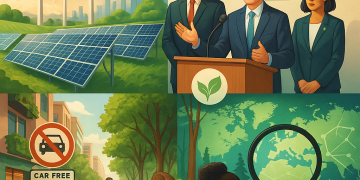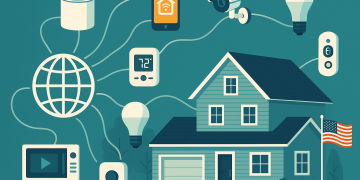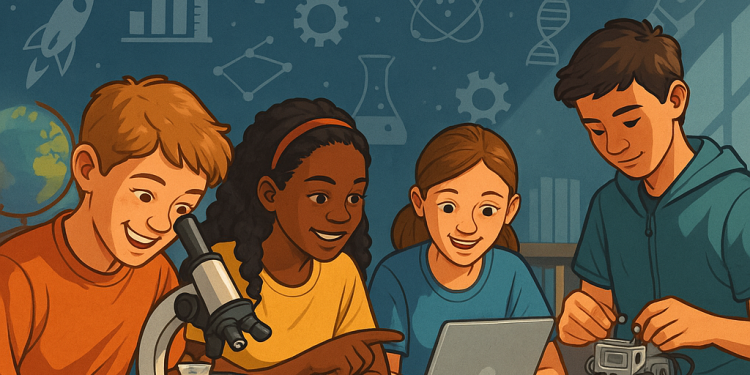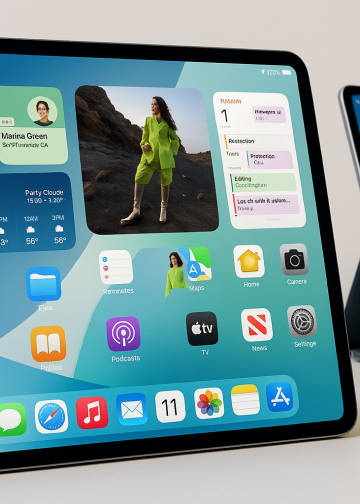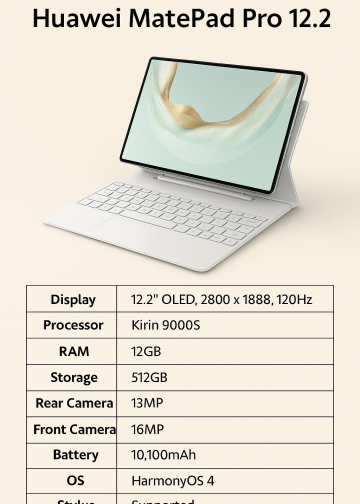Introduction: Why STEM Matters Now More Than Ever
When you think of the world’s biggest breakthroughs—from sending astronauts to the moon to building the internet and smartphones—one thing ties them all together: STEM. That’s Science, Technology, Engineering, and Mathematics. STEM education USA isn’t just a buzzword; it’s the fuel that powers American innovation and shapes the future.
But in 2024 and beyond, it’s more than robots and rocket launches. It’s about preparing every young American to solve real-world problems, think critically, and contribute to a fast-changing society. So, how are American schools science programs adapting? What are the top science education trends? And how can parents, teachers, and communities help inspire the future scientists and inventors the world needs?
1. The State of STEM Education in the USA
A National Priority
In recent years, STEM has become a cornerstone of American education policy. Lawmakers, school boards, and business leaders alike agree: growing a diverse, skilled workforce in STEM is crucial to the nation’s prosperity and security.
- Government investment: Initiatives like the Every Student Succeeds Act and state STEM grants fund teacher training, lab upgrades, and new curriculum.
- Private sector support: Tech giants (like Google, Apple, and Microsoft) fund coding camps, robotics leagues, and mentorship programs.
- Public awareness: Campaigns highlight the value of science literacy and tech skills for every student—not just the “geniuses.”
Yet, despite progress, challenges remain. Not all schools offer robust STEM programs, and gaps persist—especially for girls, minorities, and rural students.
2. Why STEM? The Benefits for Students and Society
STEM education isn’t just about creating the next Einstein or Elon Musk. It delivers practical, lifelong benefits for students at every level:
a. Critical Thinking & Problem-Solving
Hands-on science and engineering challenges teach kids to experiment, analyze data, and learn from mistakes. These skills are vital in any job—and in life.
b. Creativity & Innovation
Whether it’s building a robot or designing an app, STEM empowers students to invent, imagine, and turn ideas into reality.
c. Career Opportunities
STEM careers are among the fastest-growing and best-paying in the USA—from software engineers and biotech researchers to architects and data scientists.
d. Global Competitiveness
America’s ability to lead in tech, medicine, and industry depends on a workforce fluent in STEM.
e. Equity & Inclusion
Strong STEM programs can level the playing field, giving every child—from every background—the chance to succeed.
3. Science Education Trends Shaping American Classrooms
What’s new and exciting in American STEM education? Here are the top science education trends:
a. Project-Based Learning
Forget rote memorization—students now learn by doing. They build rockets, design eco-friendly cities, and solve real problems through hands-on projects.
b. Coding for All Ages
Coding isn’t just for high school anymore. Many American schools start teaching computer science as early as kindergarten, using visual languages like Scratch or playful robots.
c. Maker Spaces and Fab Labs
Libraries and classrooms feature 3D printers, laser cutters, and DIY electronics stations—places where creativity and engineering meet.
d. Robotics and Competitive Teams
Robotics competitions (like FIRST Robotics and VEX) attract thousands of students nationwide, combining teamwork, engineering, and friendly rivalry.
e. Interdisciplinary Learning
STEM now blends with art, music, and even language arts—known as STEAM (A for Arts)—to show students how science connects to every aspect of life.
f. Real-World Connections
Partnerships with local businesses, museums, and universities bring working scientists and engineers into the classroom.
g. Online and Virtual Labs
Remote learning and digital simulations allow students to conduct chemistry experiments or program robots—even from home.
4. How American Schools Are Inspiring Future Scientists
a. Innovative Teaching Approaches
- Inquiry-based science: Students ask questions, investigate, and develop experiments (rather than just reading textbooks).
- Flipped classrooms: Teachers deliver lectures online as homework, reserving class time for experiments and collaboration.
- Cross-curricular projects: For example, a math class might build and test bridges, blending engineering with geometry.
b. Diversity & Inclusion in STEM
Efforts to close opportunity gaps are everywhere:
- Girls in STEM clubs encourage young women to pursue science.
- Minority outreach programs provide mentorship, scholarships, and role models.
- Rural STEM initiatives bring labs, internet, and competitions to remote areas.
c. Teacher Training & Support
Quality STEM education depends on passionate, well-trained teachers:
- States fund professional development and summer institutes.
- Universities and companies offer externships and fellowships for science educators.
5. Challenges Facing STEM Education in the USA
Despite major progress, barriers remain:
a. Funding Gaps
Not all schools can afford modern labs, computers, or field trips—creating inequities between rich and poor districts.
b. Shortage of Qualified Teachers
There’s a nationwide need for more science and math teachers, especially in underserved areas.
c. Stereotypes and Bias
Old ideas (like “girls aren’t good at math” or “scientists don’t look like me”) still discourage many students from exploring STEM.
d. Curriculum Overload
Teachers face pressure to cover many topics quickly—sometimes at the expense of deep understanding or creativity.
6. The Future of STEM Careers in America
The US Bureau of Labor Statistics projects that STEM jobs will grow by nearly 11% between 2022 and 2032—much faster than average.
Top-growing fields include:
- Computer science and cybersecurity
- Green energy engineering (solar, wind, battery tech)
- Biomedical research and healthcare innovation
- Data science and artificial intelligence
- Aerospace and advanced manufacturing
Salary advantage: The median annual wage for STEM occupations is about twice that of non-STEM jobs!
7. How Parents and Communities Can Support STEM Education
It’s not just about what happens at school. Here’s how families and communities can make a difference:
a. Encourage Curiosity
Answer kids’ questions (even the tough ones), explore nature, and celebrate science fairs and “maker” projects.
b. Access Local Resources
- Visit science museums and planetariums.
- Join 4-H, Scouts, or afterschool STEM clubs.
- Attend STEM family nights at schools.
c. Embrace Technology
Explore coding apps, educational YouTube channels, or online challenges together as a family.
d. Promote Role Models
Share stories of diverse scientists, engineers, and inventors—past and present.
8. The Role of Policy and Industry in American STEM Education
a. National Initiatives
Federal agencies (like the National Science Foundation and NASA) fund research, teacher training, and student competitions.
b. Industry Partnerships
American companies offer internships, sponsor robotics teams, and help shape curriculum to match workforce needs.
c. State and Local Programs
Many states set standards for STEM learning, provide extra funding, and encourage schools to experiment with new teaching models.
9. Success Stories: STEM Inspiration from Across the USA
a. The Rise of Young Inventors
From middle schoolers patenting water filters to high school teams launching satellites, students are solving real-world problems and making headlines.
b. Girls Who Code
This national nonprofit has introduced hundreds of thousands of girls to computer science—helping close the gender gap.
c. FIRST Robotics
Teams of students, mentored by engineers, design and build robots for exciting competitions—gaining skills and confidence along the way.
10. Table: STEM Pathways—Options for American Students
| Grade Level | Example Activities | Future STEM Impact |
|---|---|---|
| Elementary School | Science fairs, coding games, field trips | Builds curiosity and confidence |
| Middle School | Robotics clubs, math contests, online courses | Strengthens skills and teamwork |
| High School | AP classes, internships, research projects | Prepares for college/careers |
| College | STEM majors, co-ops, research labs | Launches future scientists |
11. Resources for STEM Education in the USA
- National Science Teaching Association
- Code.org
- NASA STEM Engagement
- Society of Women Engineers
- FIRST Robotics
Conclusion: Building Tomorrow’s Innovators
Inspiring the next generation of scientists is a team effort. STEM education USA is about curiosity, hard work, and a belief that anyone can change the world. Whether you’re a parent, teacher, policymaker, or student, your role matters.
By embracing new science education trends, supporting teachers and diverse learners, and connecting classroom lessons to real-world impact, America can keep leading the way in technology, discovery, and innovation. The next great breakthrough is out there—waiting for a young mind, in a classroom or garage, to make it real


